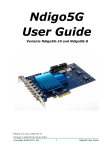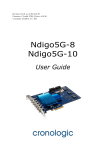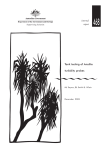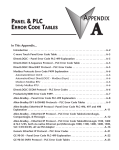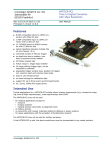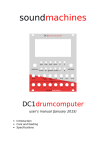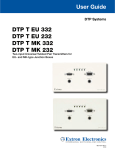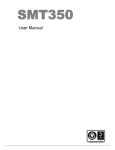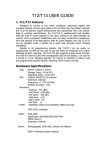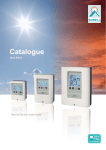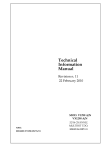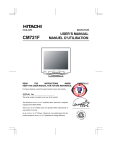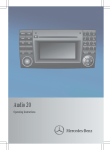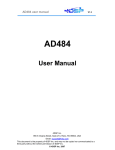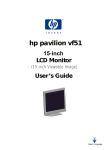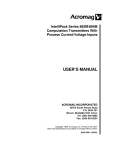Download User Manual - Cronologic
Transcript
Revision 1.2.3 as of 2015-06-10
Firmware 1 (build 4831), Driver v1.0.0
cronologic GmbH & Co. KG
cronologic
Ndigo250M-14
Ndigo125M-14
User Guide
1
Contents
1 Introduction
1.1 Features . . . . . . . . . . . . . . . . . . . . . . . . . . . . . . . . . . . . . . . . .
2 Hardware
2.1 Installing the Board . . . . . . . . . . . . . .
2.2 External Inputs and Connectors . . . . . . . .
2.2.1 Connectors . . . . . . . . . . . . . . .
2.2.2 Analog Inputs . . . . . . . . . . . . .
2.2.3 Digital Inputs . . . . . . . . . . . . . .
2.3 Extension Card . . . . . . . . . . . . . . . . .
2.4 Ndigo250M-14 Functionality . . . . . . . . . .
2.4.1 Zero Suppression . . . . . . . . . . . .
2.4.2 Trigger Blocks . . . . . . . . . . . . .
2.4.3 Gating Blocks . . . . . . . . . . . . . .
2.4.4 Auto Triggering Function Generator .
2.4.5 Timestamp Channel . . . . . . . . . .
2.4.6 Data Lookup Table . . . . . . . . . . .
2.5 Multiple Ndigo boards synchronization . . . .
2.5.1 Calibration Procedure . . . . . . . . .
2.5.2 Synchronizing with an HPTDC8-PCI
2.6 Performing a firmware update . . . . . . . . .
2.7 Calibrating the TDC . . . . . . . . . . . . . .
3 Driver Programming API
3.1 Constants . . . . . . . . . . . . . . . . . . .
3.2 Initialization . . . . . . . . . . . . . . . . .
3.2.1 Structure ndigo init parameters . . .
3.3 Status Information . . . . . . . . . . . . . .
3.3.1 Functions for Information Retrieval .
3.3.2 Structure ndigo static info . . . . . .
3.3.3 Structure ndigo param info . . . . .
3.3.4 Structure ndigo fast info . . . . . . .
3.3.5 Structure ndigo slow info . . . . . .
3.4 Configuration . . . . . . . . . . . . . . . . .
3.4.1 Structure ndigo250m configuration .
3.4.2 Structure ndigo trigger . . . . . . . .
.
.
.
.
.
.
.
.
.
.
.
.
.
.
.
.
.
.
.
.
.
.
.
.
.
.
.
.
.
.
.
.
.
.
.
.
.
.
.
.
.
.
.
.
.
.
.
.
.
.
.
.
.
.
.
.
.
.
.
.
.
.
.
.
.
.
.
.
.
.
.
.
.
.
.
.
.
.
.
.
.
.
.
.
.
.
.
.
.
.
.
.
.
.
.
.
.
.
.
.
.
.
.
.
.
.
.
.
.
.
.
.
.
.
.
.
.
.
.
.
.
.
.
.
.
.
.
.
.
.
.
.
.
.
.
.
.
.
.
.
.
.
.
.
.
.
.
.
.
.
.
.
.
.
.
.
.
.
.
.
.
.
.
.
.
.
.
.
.
.
.
.
.
.
.
.
.
.
.
.
.
.
.
.
.
.
.
.
.
.
.
.
.
.
.
.
.
.
.
.
.
.
.
.
.
.
.
.
.
.
.
.
.
.
.
.
.
.
.
.
.
.
.
.
.
.
.
.
.
.
.
.
.
.
.
.
.
.
.
.
.
.
.
.
.
.
.
.
.
.
.
.
.
.
.
.
.
.
.
.
.
.
.
.
.
.
.
.
.
.
.
.
.
.
.
.
.
.
.
.
.
.
.
.
.
.
.
.
.
.
.
.
.
.
.
.
.
.
.
.
.
.
.
.
.
.
.
.
.
.
.
.
.
.
.
.
.
.
.
.
.
.
.
.
.
.
.
.
.
.
.
.
.
.
.
.
.
.
.
.
.
.
.
.
.
.
.
.
.
.
.
.
.
.
.
.
.
.
.
.
.
.
.
.
.
.
.
.
.
.
.
.
.
.
.
.
.
.
.
.
.
.
.
.
.
.
.
.
.
.
.
.
.
.
.
.
.
.
.
.
.
.
.
.
.
.
.
.
.
.
.
.
.
.
.
.
.
.
.
.
.
.
.
.
.
.
.
.
.
.
.
.
.
.
.
.
.
.
.
.
.
.
.
.
.
.
.
.
.
.
.
.
.
.
.
.
.
.
.
.
.
.
.
.
.
.
.
.
.
.
.
.
.
.
.
.
.
.
.
.
.
.
.
.
.
.
.
.
.
.
.
.
.
.
.
.
.
.
.
.
.
.
.
.
.
.
.
.
.
.
.
.
.
.
.
.
.
.
.
.
.
.
.
.
.
.
.
.
.
.
.
.
.
.
.
.
.
.
.
.
.
.
.
.
.
.
.
.
.
.
.
.
.
.
.
.
.
.
.
.
.
.
.
.
.
.
.
.
.
.
.
.
.
.
.
.
.
.
.
.
.
.
1
1
.
.
.
.
.
.
.
.
.
.
.
.
.
.
.
.
.
.
3
3
5
5
6
7
8
9
9
10
14
16
17
17
18
19
21
22
23
.
.
.
.
.
.
.
.
.
.
.
.
25
25
26
26
28
28
28
30
30
31
32
32
34
i
Contents
.
.
.
.
.
.
.
.
.
35
36
38
38
39
39
39
41
41
4 Packet Format
4.0.2 Output Structure ndigo packet . . . . . . . . . . . . . . . . . . . . . . . .
43
43
5 C Example
45
6 Technical Data
6.1 Operating Conditions . . . . . . . . . . . . . .
6.1.1 Environmental Conditions for Operation
6.1.2 Environmental Conditions for Storage .
6.2 Digitizer Characteristics . . . . . . . . . . . . .
6.3 TDC Characteristics . . . . . . . . . . . . . . .
6.4 Electrical Characteristics . . . . . . . . . . . .
6.4.1 Oscillator . . . . . . . . . . . . . . . . .
6.4.2 Power Supply . . . . . . . . . . . . . . .
6.4.3 Analog Inputs . . . . . . . . . . . . . .
6.4.4 Digital Inputs . . . . . . . . . . . . . . .
6.5 Information Required by DIN EN 61010-1 . . .
6.5.1 Manufacturer . . . . . . . . . . . . . . .
6.5.2 Intended Use and System Integration .
6.5.3 Cooling . . . . . . . . . . . . . . . . . .
6.5.4 Environmental Conditions . . . . . . . .
6.5.5 Inputs . . . . . . . . . . . . . . . . . . .
6.5.6 Recycling . . . . . . . . . . . . . . . . .
49
49
49
49
49
50
50
50
50
50
51
52
52
52
52
53
53
53
3.5
3.6
ii
3.4.3 Structure ndigo trigger block . . . .
3.4.4 Structure ndigo gating block . . . .
3.4.5 Structure ndigo extension block . . .
3.4.6 Run Time Control . . . . . . . . . .
Readout . . . . . . . . . . . . . . . . . . . .
3.5.1 Input Structure ndigo250m read in .
3.5.2 Input Structure ndigo250m read out
Other Functions . . . . . . . . . . . . . . .
3.6.1 LED control . . . . . . . . . . . . . .
.
.
.
.
.
.
.
.
.
.
.
.
.
.
.
.
.
.
.
.
.
.
.
.
.
.
.
.
.
.
.
.
.
.
.
.
. .
.
. .
. .
. .
. .
. .
. .
. .
. .
. .
. .
. .
. .
. .
. .
. .
.
.
.
.
.
.
.
.
.
.
.
.
.
.
.
.
.
.
.
.
.
.
.
.
.
.
.
.
.
.
.
.
.
.
.
.
.
.
.
.
.
.
.
.
.
.
.
.
.
.
.
.
.
.
.
.
.
.
.
.
.
.
.
.
.
.
.
.
.
.
.
.
.
.
.
.
.
.
.
.
.
.
.
.
.
.
.
.
.
.
.
.
.
.
.
.
.
.
.
.
.
.
.
.
.
.
.
.
.
.
.
.
.
.
.
.
.
.
.
.
.
.
.
.
.
.
.
.
.
.
.
.
.
.
.
.
.
.
.
.
.
.
.
.
.
.
.
.
.
.
.
.
.
.
.
.
.
.
.
.
.
.
.
.
.
.
.
.
.
.
.
.
.
.
.
.
.
.
.
.
.
.
.
.
.
.
.
.
.
.
.
.
.
.
.
.
.
.
.
.
.
.
.
.
.
.
.
.
.
.
.
.
.
.
.
.
.
.
.
.
.
.
.
.
.
.
.
.
.
.
.
.
.
.
.
.
.
.
.
.
.
.
.
.
.
.
.
.
.
.
.
.
.
.
.
.
.
.
.
.
.
.
.
.
.
.
.
.
.
.
.
.
.
.
.
.
.
.
.
.
.
.
.
.
.
.
.
.
.
.
.
.
.
.
.
.
.
.
.
.
.
.
.
.
.
.
.
.
.
.
.
.
.
.
.
.
.
.
.
.
.
.
.
.
.
.
.
.
.
.
.
.
.
.
.
.
.
.
.
.
.
.
.
.
.
.
.
.
.
.
.
.
.
.
.
.
.
.
.
.
.
.
.
.
.
.
.
.
.
.
.
.
.
.
.
.
.
.
.
.
.
.
.
.
.
.
.
.
.
.
.
.
.
.
.
.
.
.
.
.
.
.
.
.
.
.
.
.
.
.
.
.
.
.
.
.
.
.
.
.
.
.
.
.
.
.
.
.
.
.
.
.
.
1 Introduction
The Ndigo250M and Ndigo125M are digitizer and transient recorders designed to sample relatively shorts pulses in rapid repetition. They produce a stream of output packets, each containing
data from a single trigger event together with a timestamp.
1.1 Features
14 bit dynamic range
up to 250 Msps sample rate
4 channels
digital input with TDC that can also be used for gating and triggering
2nd digital input for gating or triggering
PCIe x8 Gen 1 with 1400 MB/s throughput
multiple boards can be synchronized
The Ndigo125M and Ndigo250M are almost identical. The only difference is the use of a
slower ADC in the Ndigo125M. If not otherwise noted this user guide refers to both boards
when using the term ‘Ndigo250M’ or ‘Ndigo250M-14’. These boards are conceptionally very
similar to the Ndigo5G-10 and use an almost identical API. All three types of boards can be
mixed and synchronized by using the cronotools software library. The Ndigo5G-10 merges all
data channels into a single ring buffer whereas the Ndigo250M has a separate buffer for each
channel.
1
2 Hardware
2.1 Installing the Board
The Ndigo250M-14 board can be installed in any PCIe slot with eight or more lanes. If the slot
electrically supports less than 8 lanes, the board will operate at lower data throughput rates.
Using a single Ndigo250M, no further connections need to be made. For applications that
require more than four ADC channels, several Ndigo boards can be operated in sync. Any
board of the Ndigo product line can be synced to other Ndigo boards, allowing, for instance, for
a combination of high speed ADCs (Ndigo5G) and slower high resolution ADCs (Ndigo250M-14)
or the upcoming Ndigo TDC.
The signals used for board synchronization and inter-board triggering are transferred on a
bus between the boards. Join all C2 connectors (see Figure 2.3 on page 5) on the boards using
a ribbon cable. Both ends of the bus need to be terminated properly. If using a Ndigo Crate,
connectors providing the termination are located on the crate mainboard next to the PCIe slots
to the extreme left and right. For more details, please refer to the Ndigo Crate user guide. In
applications that use only a few Ndigo boards installed directly inside a PC, termination PCBs
available from cronologic can be used.
Ndigo250M’s standard device driver can be used to read out any number of boards and acquire
data. For more complex scenarios, using the cronoSync-library, which is part of cronoTools, is
recommended. The cronoSync library is provided with the Ndigo device driver. Please refer to
the cronoTools user guide for more information.
3
termination
C2
C2
C2
termination
C1
C1
C1
Figure 2.1: If several Ndigo boards are connected to work in sync , the boards must be connected using a ribbon cable as bus for synchronization and trigger signals. Proper
termination is required at both ends of the cable.
cronologic GmbH & Co. KG
4
Ndigo250M-14 User Guide
2.2 External Inputs and Connectors
2.2.1 Connectors
Trigger
T
Gate
D
C
B
A
G
Ndigo
250M-14
cronologic
The inputs of the Ndigo250M-14 are located on the PCI bracket. Figure 2.3 on page 5 shows the
location of the 4 analog inputs A to D and the two digital inputs G (GATE) and T (TRIGGER).
Furthermore, a board interconnection connector (C2) can be found at the top edge of the
Ndigo250M-14, as displayed in Figure 2.3 on page 5. Connector C2 is used as a bus interface
between multiple Ndigo boards. It is used for distributing clock, trigger and sync signals. Proper
termination must be placed at both ends of the bus interconnection ribbon cable, as shown in
figure 2.1.
Figure 2.2: Input connectors of an Ndigo250M-14 located on the PCI bracket.
C2
T
D
C
B
A
G
Figure 2.3: Schematics of an Ndigo250M-14 board showing inter-board connector C2.
cronologic GmbH & Co. KG
5
Ndigo250M-14 User Guide
450MHz
offset
+
-
Figure 2.4: Input circuit for each of the four analog channels.
2.2.2 Analog Inputs
The analog inputs of the ADC are single ended LEMO00 coax connectors. The inputs have a
50Ω impedance and are DC coupled. The inputs are converted to a differential signal using an
operational amplifier. The input voltage range is 1Vp-p centered around a programmable offset
voltage. See section 6.4.3 for details.
Analog Offsets
+0.5 V
+0.5V
0.2V
-0.5 V
-0.5 V
analog_offset[i] = 0V
analog_offset[i] = 0.2V
Figure 2.5: Users can subtract an analog offset from the input before sampling at the ADC
Users can set the approximate center of the input voltage range individually for each channel
by using the analog offset parameter. The valid voltage range for the offset is 0 . . . 2.5V . All
cronologic GmbH & Co. KG
6
Ndigo250M-14 User Guide
input parameters are specified in section 6.4.3. This feature is especially useful for highly
+0.5V
+0.5V
analog_offset[i] = 0.43V
0.43V
analog_offset[i] = 0V
-0.5 V
-0.5 V
Figure 2.6: Asymmetric signal shifted to increase dynamic range
asymmetric signals, such as pulses from TOF spectrometers or LIDAR systems. By shifting
the DC baseline to one end of the ADC range, the input range can be used fully, providing the
maximum dynamic range.
2.2.3 Digital Inputs
There are two digital inputs on the front slot cover called TRIGGER and GATE.
Both inputs provide a digital input signal routed to the trigger matrix. These signals can
be used to trigger any of the trigger state machines and gating blocks. The inputs are AC
coupled. The DC offset is configurable via the parameters analog offset[4] for TRIGGER and
analog offset[5] for GATE in the configuration structure. See section 3.4.1 for a definition of the
configuration structure.
TRIGGER
TDC
analog_offset[4]
Figure 2.7: TRIGGER and GATE are AC coupled inputs with programmable threshold. (Only
TRIGGER shown)
For the digital signals the offset directly sets the discrimination threshold at which edges are
detected. To support both negative and positive pulses the valid range is -1.25V to +1.25V.
To prevent inter symbol interference caused by the AC coupling, the distance between adjacent
pulses should be much longer than the width of each of the pulses.
The FPGA input logic is shown in Figure 2.13 on page 12.
cronologic GmbH & Co. KG
7
Ndigo250M-14 User Guide
1,0V
analog_offset[4]
-1,0V
Figure 2.8: For TRIGGER and GATE negative thresholds can be set to support negative signals
such as 16mA NIM.
TDC on Input TRIGGER
There is a TDC connected to the input TRIGGER. When used with the TDC, input TRIGGER
supports negative pulses only and analog offset[4] must be negative. The TDC creates packets
of type 8. These packets first contain a coarse timestamp and a payload that can be used to
calculate the trigger position with higher precision. The function ndigo process tdc packet() can
be used to replace the coarse timestamp with the precise timestamp. This function is described
in section 3.5 on page 39. TDC pulses must have a minimum duration of 3.3ns. The dead-time
of the TDC is 32ns. The TDC is only enabled if the divisor is set to 2. For the Ndigo 125M
board the divisor has to be at least 4. Thus the TDC is disabled for this board. For lower
sampling frequencies the decimation option can be used.
2.3 Extension Card
This Option is only available for the Ndigo5G-10.
cronologic GmbH & Co. KG
8
Ndigo250M-14 User Guide
2.4 Ndigo250M-14 Functionality
The analog input signal is quantized to 14 bits. However, the board always scales and offsets
the data to 16 bit signed data centered around 0.
Interleaving of multiple channels is not supported
2.4.1 Zero Suppression
One of Ndigo250M’s key features is on-board zero suppression to reduce PCIe bus load. Only
data that passes specifications predefined by the user is transmitted. This guide refers to the
data structure in which wave form data is transmitted as “packets”. A packet contains the wave
form data and a timestamp giving the absolute time (i.e. the time since start of data acquisition)
of the packet’s last sample.
Figure 2.9 shows a simple example: Data is written to the PC only if values exceed a specified
threshold. Expanding on that, Ndigo250M’s zero suppression can be used to realize much more
complex scenarios.
Retrigger
Postcursor
timestamp
timestamp
Precursor
Figure 2.9: Simple zero suppression: Only data with values above a threshold are written to the
PC.
cronologic GmbH & Co. KG
9
Ndigo250M-14 User Guide
2.4.2 Trigger Blocks
The Ndigo250M-14 records analog wave forms using zero suppression. Whenever a relevant
waveform is detected, data is written to an internal FIFO memory. Each ADC channel has
one trigger block determining whether data is written to the FIFO. The parameters are set in
Structure ndigo trigger block(See chapter 3.4.3 on page 35).
Each trigger block consists of two independent units that check the incoming raw data stream
for trigger conditions (Fig. 2.9 on page 9). Users can specify a threshold and can choose whether
triggering happens whenever incoming data is below or above the threshold (level triggering) or
only in the moment data crosses the threshold (edge triggering).
A gate length can be set to extend the trigger window. Furthermore, if users choose precursor
values > 0, the trigger unit will start writing data to the FIFO precursor samples before the
trigger event.
When using edge triggering, all packets have the same length (Figure 2.10 on page 11):
precursor + length + 1 cycles. For level triggering, the packet length is data dependent (Figure
2.11 on page 11).
For the Ndigo250M-14 the triggering is sample accurate.
If retriggering is active, the current trigger window is extended if a trigger event is detected
inside the window. The extension lasts length cycles after the last sample trigger event.
A trigger block can use several input sources:
the 8 trigger decision units of all four ADC channels (Figure 2.12 on page 12)
the GATE input (Figure 2.13 on page 12)
the TRIGGER input (Figure 2.13 on page 12)
a function trigger providing random or periodic triggering (Section 2.4.4 on page 16)
triggers originating from other cards connected with the sync cable or from the Ndigo
Extension card (BUS0, BUS1, BUS2, BUS3)
A second set of trigger units for the digital inputs TRIGGER, GATE, BUS0, BUS1, BUS2,
and BUS3 that is set in hardware to positive edge triggering. This set of triggers is not
available as inputs for the gate blocks.
Trigger inputs from the above sources can be combined using logical “OR” (Figure 2.14 on
page 13) by setting the appropriate bits in the trigger blocks source mask.
Triggers can be fed into the gating blocks described on page 14 (Figure 2.15). Gating blocks
can be used to block writing data to the FIFO. That way, only zero suppressed data occurring
when the selected gate is active is transmitted. This procedure reduces PCIe bus load even
further (Figure 2.15).
cronologic GmbH & Co. KG
10
Ndigo250M-14 User Guide
total length = 19
length = 12
threshold
precursor = 6
Figure 2.10: Parameters for edge triggering
total length = 21
length = 6
threshold
precursor = 6
Figure 2.11: Parameters for level triggering
cronologic GmbH & Co. KG
11
Ndigo250M-14 User Guide
trigger 1
Z-1
sample data
threshold
rising
edge
trigger 2
Z-1
threshold
rising
edge
Figure 2.12: From the ADC inputs, a trigger unit creates an input flag for the trigger matrix.
Each digitizer channel (A, B, C, D) has two trigger units.
Z-1
input
rising
edge
Figure 2.13: The digital inputs TRIGGER, GATE, BUS0, BUS1, BUS2 and BUS3 have trigger
units without a programmable threshold.
cronologic GmbH & Co. KG
12
Ndigo250M-14 User Guide
ext0 extension
sync0 block
ext1 extension
sync1 block
ext2 extension
sync2 block
ext3 extension
sync3 block
digital
trigger
digital
trigger
digital
trigger
digital
trigger
digital
trigger
bus0_pe
bus0
bus1_pe
bus1
bus2_pe
bus2
bus3_pe
bus3
1
func_trig
GATE
gate_pe
gate
TRIGGER
D1
digital
trigger
tdc_pe
tdc
analog
trigger
C0
C1
D
analog
trigger
D0
C
B0
B1
B
analog
trigger
A1
analog
trigger
A0
A
Gates
trigger_
block[0]
trigger_
block[1]
trigger_
block[2]
trigger_
block[3]
time stamp
channel
bus[0]
bus[2]
bus[3]
to cable sync
bus[1]
Figure 2.14: Trigger Matrix: The trigger signals of each ADC channel, the TRIGGER input,
the GATE input or the sync cable can be combined to create a trigger input for
each trigger block. The four gate signals can be used to suppress triggers during
certain time frames.
cronologic GmbH & Co. KG
13
Ndigo250M-14 User Guide
2.4.3 Gating Blocks
Figure 2.15: Gating Blocks: Each gating block can use an arbitrary combination of inputs to
trigger its state machine. The outputs can be individually inverted and routed to
the AND-gate feeding the trigger blocks.
To decrease the amount of data transmitted to the PC, the Ndigo250M-14 includes 4 independent gate and delay units. A gate and delay unit creates a gate window starting at a specified
time after a trigger, closing the window at gate stop.
Trigger blocks can use the gate signal to suppress data acquisition: Only data that fulfills
zero sup-pression specifications occurring in an active gate window is written to the PC.
All triggers from the 4 trigger blocks, the GATE and TRIGGER inputs, triggers from a
connected board and the function generator can be used as inputs.
The retrigger feature will create a new gate if a trigger occurs during an active gate window.
The gate signal can be inverted, causing an active gate to close for a time defined by the user.
The parameters of a gating block are set in structure ndigo gating block described on page 36.
cronologic GmbH & Co. KG
14
Ndigo250M-14 User Guide
Figure 2.16 shows the functionality of the gate timing and delay unit. Active gate time is
marked in green.
Trigger
Gate
Gate Start
Gate Stop
Figure 2.16: Gate and delay functionality: When a trigger occurs, the gate opens after a set
period of time (“gate start”) and closes when it reaches “gate stop”.
Gating Example 1: Suppression of Noise After Starting an Acquisition
In mass spectrometer and other experiments, noise while starting data acquisition can result
in undesired trigger events for that time period. To prevent noise in the output data, a gating
block could be used to suppress all triggers during start-up.
The following example illustrates the use of a gating block to prevent noise: The GATE input
transmits a pulse on each acquisition start. The trigger structure of the GATE input is used to
select pulse polarity. Then, the GATE trigger is selected as gating block input and the gating
block’s start parameter is set to 0. The stop parameter is set to the desired length measured in
3.2ns clock cycle and negate is set to true. The gating block will now output a low pulse of the
desired length whenever there is a pulse on the GATE input.
Enabling this gating block as an AND input to the trigger block, for which noise shall be
suppressed.
Gating Example 2: Delayed Trigger
To sample a short window at a specified time after a trigger event on a channel, the gating
block can be used to create a delayed trigger. To do this, one of the triggers of the channel of
interested is configured to the desired parameters by selecting the threshold, setting the edge
polarity and enabling edge triggering.
Instead of directly using this trigger as input to the trigger block’s input matrix, the trigger
is selected as an input to a gating block. The block is configured to start = delay and stop =
start + 1, negate = f alse. This causes the gating block to produce a one clock cycle pulse on
cronologic GmbH & Co. KG
15
Ndigo250M-14 User Guide
its output after the specified delay.
To send this pulse to the trigger block, the gating block must be enabled in the trigger block’s
AND matrix and the ONE trigger source must be selected.
2.4.4 Auto Triggering Function Generator
Some applications require periodic or random triggering. Ndigo250M’s function generator provides this functionality.
The delay between two trigger pulses of this trigger generator is the sum of two components:
A fixed value M and a pseudo random value given by the exponent N.
The period is
T = 1 + M + [1...2N ]
(2.1)
samples.
This allows to monitor input signals at times the current trigger configuration does not trigger,
e. g. to get base line information in mass spectrometry applications. It can also be used to
determine a suitable threshold level for the trigger by first getting random statistics on the input
signal.
Auto Triggering Example 2: Continuous Data Retrieval
With the Ndigo250M it is possible to sample and process data continuously. For that, one
defines the length of the packet and configures the auto trigger accordingly.
Choosing the length of a packet is always a tradeoff between having to process headers for
short packets (see further down and 4.0.2) and increasing the latency for long packets. The
latter is due to the fact, that the driver only returns complete packets.
The length of the data is set in words (maximum 4093) which contain 4 samples of length
4ns each. The packet thus includes a header (see 4.0.2), the timestamp of the last word in the
packet and the data. Using pointer arithmetics one can directly access the data in the packet,
ignoring header and timestamp.
Setting the auto trigger analogously to equation 2.1 to M = S − 1 and N = 0, with S the
number of samples in each packet, one obtains a closed cycle of triggering and data recording.
To enable the auto trigger one has to configure the trigger block of the current channel with
length = S and sources = NDIGO TRIGGER SOURCE AUTO and enable it.
cronologic GmbH & Co. KG
16
Ndigo250M-14 User Guide
2.4.5 Timestamp Channel
The timestamp channel produces a stream of small packets that denote the time of the trigger
event. An arbitrary set of trigger sources can be selected in the trigger matrix to cause the
creation of a packet.
The packets have a fixed length of 16 bytes. The format is described on page 43. The length
field of the packet contains a 32 bit pattern that contains the levels of all trigger sources at the
time of the trigger event except for the period monitor. Only one packet is created, no matter
how many trigger sources caused the timestamp channel to trigger. The timestamp channel can
be gated.
2.4.6 Data Lookup Table
This feature ist not available for the Ndigo250M-14.
cronologic GmbH & Co. KG
17
Ndigo250M-14 User Guide
2.5 Multiple Ndigo boards synchronization
Using several Ndigo devices in applications that use more channels than a single board can
provide requires synchronized operation. To ensure exact synchronization, a delay parameter
needs to be set for each board. This parameter might change in case boards are swapped, added
or removed and in some cases might change after a firmware update.
The calibration tool “MultiboardCalibration.exe” is available after installing the Ndigo device
driver. It is used to find appropriate delay values for each board in a given board setup. After
starting, the application lists all Ndigo boards found (Figure 2.17).
Figure 2.17: Main window of the multiple boards sync calibration tool.
A board’s appropriate delay depends on whether it operates in master or slave mode. The
respective values can be set in the column “Delay M” (for master boards) and “Delay S” (for
slave boards). The designated master board can be selected in the column “Master”. The
calibration procedure creates a histogram for each board, displaying the current delay between
the boards. The histogram can be viewed by clicking on “Show!”. When the appropriate delay
values are found, they can be stored in the on-board flash prom by clicking “Do it!” separately
for each board. Clicking “Flash All!” will write the values to all boards at once. Please note:
Flashing the values might take up to 10 seconds during which the program might not respond.
Important note:If the application reports a “PLL not locked” error check the cable. If the
recording of histograms does not make progress check the cable. Make sure the cable is properly
terminated at both ends and firmly attached to each card.
cronologic GmbH & Co. KG
18
Ndigo250M-14 User Guide
2.5.1 Calibration Procedure
1. Make sure the “Automode” is selected.
2. Record the calibration histograms by pressing “Record histograms”. The program will
perform up to 200 measurements of the sync delay. After accumulating some data, the
delay values found are reported in the column “AutoMmt”. The values can be verified
by examining histogram that was recorded. A board’s histogram should look like the one
shown in Figure 2.18. During normal operation the delay will be adjusted such, that the
data points accumulated roughly coincide with the vertical markers in the upper panel.
As the delay pattern is periodic, valid delay values are between 0 and 31. Thus, the
delay value found by the auto measurement should correspond to the distance between
the vertical markers and accumulated data points. Hint: when moving the mouse pointer
across the histogram the delay value of the current location is displayed.
3. After stopping the data acquisition (by pressing “Record Histograms” again) the delay
values of the auto measurement need to be copied to the columns “Delay M” or “Delay
S” depending on the corresponding board being a master or a slave. The correct field to
copy the value to is highlighted in green.
4. you may record recorded a new dataset as a crosscheck that the delay is now set to an
appropriate value. By disabling “Automode” the new delay values are used. Press “Record
Histograms” in order to start the data acquisition. After some time the histogram should
look similar to the one in Figure 2.19.
5. The delay values for all boards in a set needs to be found. For the case a board acts as
a master, the value “Delay M” needs to be adjusted, in case it is a slave, the “Delay S”
parameter needs to be changed. In order to find the master-case delay values for all boards,
the calibration procedure needs to be performed with every board acting as a master once.
After changing the master board, the slave values of the other boards don’t need to be
readjusted. Only Ndigo5G boards may be set as masters. Therefore, a Ndigo250M board
only needs to be calibrated as a slave.
6. After finding all delay values, write the values to the on-board flash PROMs by pressing
“Flash All!”.
cronologic GmbH & Co. KG
19
Ndigo250M-14 User Guide
Figure 2.18: Histogram for the case the delay value for the board is not set correctly. Please
note: the lower panel might differ from board to board, with the “step” being at a
different position.
Figure 2.19: Histogram for the case the delay value for the board is set correctly. Please note: the
lower panel might differ from board to board, with the “step” being at a different
position.
cronologic GmbH & Co. KG
20
Ndigo250M-14 User Guide
2.5.2 Synchronizing with an HPTDC8-PCI
The Ndigo250M-14 does not support synchronization with an HPTDC8-PCI.
cronologic GmbH & Co. KG
21
Ndigo250M-14 User Guide
2.6 Performing a firmware update
After installing the Ndigo device driver, a firmware update tool is available. By choosing
“NdigoFirmwareGUI.exe” a firmware update can be performed. After invoking the application a window as shown in Figure 2.20 will appear. The tool can be used for updating the
firmware and to create a backup of the on-board calibration data of the Ndigo unit. If several
boards are present, the one which is going to be used can be selected in the upper left corner of
the window.
“Backup” When pressing the “Backup” buttons a backup of the firmware or the calibration
data will be created, respectively.
“Browse” In order to perform a firmware update, chose the “.ndigorom”-file to be used by
pressing “Browse”. The file contains the firmware proms for all boards of the Ndigo
product line.
“Flash” By pressing “Flash” the firmware is written to the board.
“Verify” “Verify” can be used to compare the data stored inside the prom to the one inside a
file.
Figure 2.20: The firmware update and calibration data backup tool as provided with the Ndigo
device driver.
Important note: The new firmware will only be used after a power cycle, i.e. after switching
the PC (or Ndigo crate) off and back on. A simple reboot is not sufficient. Therefore the
cronologic GmbH & Co. KG
22
Ndigo250M-14 User Guide
information shown in the upper half of the application window does not change right after
flashing a new firmware.
2.7 Calibrating the TDC
After each update of the Ndigo250M-14 firmware the TDC has to be calibrated. The calibration
is done with the tool “TDC Calibration.exe” which is available after installing the Ndigo device
driver. After invoking the application a window as shown in Figure 2.21 will appear.
Figure 2.21: The TDC calibration tool as provided with the Ndigo device driver.
The calibration procedure is as follows:
1. Connect an external pulse signal to the Trigger input. The signal should be low active
with a frequency in the kHz range. It must not be synchronized to the clock source of the
Ndigo250M-14. The input frequency must not exceed 10 MHz. The pulse low and high
width has to be at least 10ns each.
2. Set Serial Number according to the sticker on the card if the shown value is not correct.
3. Start capturing pulse events by pressing the Start button.
4. Adjust the Input Offset so that First Bin is in the range of 4 to 16. First Bin is less than
4, increment Input Offset by one. If First Bin is greater than 16 decrement Input Offset
by one. Repeat increment/decrement until First Bin is in the range of 4 to 16. Depending
on the firmware revision the Input Offset value for a successful calibration may be in the
range of 6 to 10 or 28 to 32.
cronologic GmbH & Co. KG
23
Ndigo250M-14 User Guide
5. When the Write Calibration Data button becomes enabled press it to update the calibration data on the card.
6. Calibration done!
The card can only be successfully calibrated if:
First Bin is in the range of 4 to 16
Empty Bins is less than (First Bin + 4)
at least 10,000 events have been captured
a valid serial number is set.
Important note: If the application reports an error check if the input pulse is within specification.
cronologic GmbH & Co. KG
24
Ndigo250M-14 User Guide
3 Driver Programming API
The API is a DLL with C linkage. There also exists a .Net wrapper.
The functions provided by the DLL are declared in Ndigo250M interface.h and Ndigo common interface.h.
3.1 Constants
#define NDIGO250M CHANNEL COUNT 4
The number of analog input channels.
#define NDIGO250M GATE COUNT 4
The number of gating blocks.
#define NDIGO250M TDC COUNT 1
The number of TDC channels.
#define NDIGO250M DMA COUNT 6
The number of DMA channels. Unlike the Ndigo5G-10, this device has an individual DMA
buffer for each data source.
#define NDIGO250M FIFO DEPTH 4094
Number of samples that can be buffered before readout. Longer packets are possible under
certain circumstances.
25
3.2 Initialization
int ndigo250m count devices(int *error code, char **error message)
Return the number of boards that are supported by this driver in the system.
int ndigo250m get default init parameters(ndigo init parameters *init)
Get a set of default parameters to feed into ndigo init(). This must always be used to initialize
the ndigo init parameter structure.
ndigo device *ndigo250m init(ndigo init parameters *params, int *error code, char **error message)
Open and initialize the Ndigo250M-14 board with the given index. With error code and error message the user must provide pointers where to buffers where error information should be
written by the driver. The buffer for the error message must by at least 80 chars long.
Params is a structure of type ndigo init parameters that must be completely initialized.
int ndigo close(ndigo device *device)
Finalize the driver for this device.
3.2.1 Structure ndigo init parameters
int version
Must be set to NDIGO API VERSION
int card index
The index in the list of Ndigo250M-14 boards that should be initialized. There might be multiple
boards in the system that are handled by this driver as reported by ndigo count devices. This
index selects one of them. Boards are enumerated depending on the PCIe slot. The lower the
bus number and the lower the slot number the lower the card index.
int board id
This 8 bit number is filled into each packet created by the board and is useful if data streams of
multiple boards will be merged. If only Ndigo250M-14 cards are used this number can be set to
the card index. If boards of different types that use a compatible data format are used in a system
each board should get a unique id. Can be changed with int ndigo set board id(ndigo device
*device, int board id).
ndigo bool t use external clock
Use 10MHz clock supplied by IPC flat band cable. Must be set for all slaves when synchronizing
multiple boards.
ndigo bool t drive external clock
Drive internal 10MHz clock of this board to IPC flat band cable. Must be set for master when
synchronizing multiple boards.
cronologic GmbH & Co. KG
26
Ndigo250M-14 User Guide
ndigo bool t is slave
Data acquisition of this board is controlled by the master board.
int sync period
Period of the multicard sync pulse. Ignored for single board setups. Should be set to 4 if only
Ndigo5G and Ndigo250M boards are present in the system. If other boards are synchronized
the correct value is the lowest common denominator of the value of all boards.
int sync delay
Fine tap delay for incoming sync signals. Ignored for single board setups.
int sync delay master
Fine tap delay for sync signals. Ignored for single board setups.
ndigo bool t force window calibration
If true/1, a valid data window is automatically detected at initialization. Default value is false/0:
values from flash memory are used in order to set the data window to correct position.
ndigo bool t hptdc sync enabled
Must be set to false.
int64 buffer size[8]
The minimum size for each of the DMA buffers. The driver will allocate a multiple of the system
page size (usually 4096 bytes). The minimum buffer size is four pages. If set to 0 the default size
of 16MByte is used. Ndigo250M-14 uses buffer size[0] to buffer size[NDIGO250M DMA COUNT1].
int buffer type
Must be set to NDIGO BUFFER ALLOCATE.
int64 buffer address
Ignored. Might be used for future buffer types.
int variant
Set to 0. Can be used to activate future device variants such as different base frequencies.
int device type
Initialized by ndigo get default init parameters(). Must be left unchanged.
#define CRONO DEVICE HPTDC 0
#define CRONO DEVICE NDIGO5G 1
#define CRONO DEVICE NDIGO250M 2
int dma read delay
Initialized by ndigo get default init parameters(). The write pointer updated is delay by this
number of 4n clock periods to hide race conditions between software and DMA.
cronologic GmbH & Co. KG
27
Ndigo250M-14 User Guide
3.3 Status Information
3.3.1 Functions for Information Retrieval
The driver provides functions to retrieve detailed information on the type of board, its configuration, settings and state. The information is split according to its scope and the computational
requirements to query the information from the board.
int ndigo get static info(ndigo device *device,ndigo static info *info)
This structure contains information about the board that does not change during run time.
int ndigo get param info(ndigo device *device, ndigo param info *info)
The structure returned by this call contains information that changes indirectly due to configuration changes.
int ndigo get fast info(ndigo device *device, ndigo fast info *info)
This call returns a structure that contains dynamic information that can be obtained within a
few microseconds.
int ndigo get slow info(ndigo device *device, ndigo slow info *info)
The data reported in this structure requires milliseconds to be obtained. The application should
only call it in situation where the program flow can cope with an interruption of that magnitude.
const char* ndigo get last error message(ndigo device *device)
3.3.2 Structure ndigo static info
This structure contains information about the board that does not change during run time. It
is provided by the function ndigo get static info.
int size
The number of bytes occupied by the structure
int version
A version number that is increased when the definition of the structure is changed. The increment can be larger than one to match driver version numbers or similar.
int board id
Index of the board as passed to the constructor or set via int ndigo set board id(ndigo device
*device, int board id).
int driver revision
The lower three bytes contain a triple level hierarchy of version numbers, e.g. 0x010103 encodes
version 1.1.3.
cronologic GmbH & Co. KG
28
Ndigo250M-14 User Guide
A change in the first digit generally requires a recompilation of user applications. Change in
the second digit denote significant improvements or changes that don’t break compatibility and
the third digit changes with minor bugfixes and similar updates.
int firmware revision
Firmware revision of the FPGA configuration. This increments only when there is a functional
change.
int board revision
int board configuration
Describes the schematic configuration of the board.
int adc resolution
Number of bits of the ADC, set to 0 if unknown. Should be 14.
double nominal sample rate
Maximum sample rate. 2.5e8 = 250Msps for the Ndigo250M and 1.25e8 = 125Msps for the
Ndigo125M.
double analog bandwidth
1.25e8 for 125MHz.
int chip id
16 bit factory ID of the ADC chip
int board serial
Serial number with the year minus 2000 in the highest 8 bits of the integer and a running number
in the lower 24 bits. This number is identical with the one on the label on the board.
int flash serial low
int flash serial high
64 bit manufacturer serial number of the flash chip.
int flash valid
If not 0 the driver found valid calibration data in the flash on the board and is using it.
ndigo bool t dc coupled
Returns true for the Ndigo250M.
int subversion revision
A number to track builds of the firmware in more detail than the firmware revision. It changes
with every change in the firmware, even if there is no visible effect for the user.
char calibration date[20]
DIN EN ISO 8601 string YYYY-MM-DD HH:DD describing the time when the card was calibrated.
cronologic GmbH & Co. KG
29
Ndigo250M-14 User Guide
3.3.3 Structure ndigo param info
int size
The number of bytes occupied by the structure.
int version
A version number that is increased when the definition of the structure is changed. The increment can be larger than one to match driver version numbers or similar.
double bandwidth
Analog Bandwidth setting of the ADC. Should be 450MHz.
double sample rate
Sample rate currenly used. sample rate = 2.5e8/divisor.
double sample period
The period one sample in the data represents in picoseconds.
int board id
The number the board uses to identify the data source in the output data stream.
int channels
Number of channels. Should be 4.
int channel mask
Mask with a set bit for each enabled input channel.
int64 total buffer
The total amount of the DMA buffer in bytes.
3.3.4 Structure ndigo fast info
This structure contains information that can be retrieved within microseconds.
int size
The number of bytes occupied by the structure
int version
A version number that is increased when the definition of the structure is changed. The increment can be larger than one to match driver version numbers or similar.
int adc rpm
Always reports 0.
int fpga rpm
Speed of the FPGA fan. Reports 0 if no fan is present.
int alerts
cronologic GmbH & Co. KG
30
Ndigo250M-14 User Guide
Alert flags from the system monitor and temperature sensor. Bits 0 to 3 are measured by the
system monitor of the FPGA. Bits 4 and 5 are provided by an external temperature sensor.
Bit
Bit
Bit
Bit
Bit
Bit
0
1
2
3
4
5
:
:
:
:
:
:
FPGA temperature alert (> 85◦ C)
Internal FPGA voltage out of range (< 1.01V or > 1.08V )
FPGA auxiliary voltage out of range. (< 2.375V or > 2.625V )
FPGA temperature critical (> 125◦ C)
FPGA temperature alert (> 90◦ C)
FPGA temperature critical (> 100◦ C)
double voltage aux
Auxiliary FPGA voltage, nominal 2.5V
double voltage int
Internal FPGA voltage, nominal 1.03V
double fpga temperature
In ◦ C measured on die by internal system monitor.
double pcie pwr mgmt
Set to 0 if link power management is turned off.
int pcie link width
Number of PCIe lanes that the card uses. Should be 8. Lower values possible if the mainboard
does not support 8 lanes in the slot chosen.
int pcie max payload
Maximum size in bytes for one PCIe transaction, depends on system configuration.
3.3.5 Structure ndigo slow info
This structure contains data that requires many milliseconds to retrieve.
int size
The number of bytes occupied by the structure.
int version
A version number that is increased when the definition of the structure is changed. The increment can be larger than one to match driver version numbers or similar. Set to 0 for all versions
up to first release.
double FPGA temperature
ADC temperature in ◦ C measured on die by external temperature sensor.
double board temperature
In ◦ C. Measured by external temperature sensor.
cronologic GmbH & Co. KG
31
Ndigo250M-14 User Guide
3.4 Configuration
The device is configured with a configuration structure. The user should first obtain a structure
that contains the default settings of the device read from an on board ROM , than modify the
structure as needed for the user application and use the result to configure the device.
int ndigo250m get default configuration(ndigo device *device, ndigo250m configuration *config)
int ndigo250m get current configuration(ndigo device *device, ndigo250m configuration *config)
int ndigo250m configure(ndigo device *device, ndigo250 configuration *config)
int ndigo set board id(ndigo device *device, int board id)
The board id can be changed after initialization of the card. If cronotools are used the board id
changes have to be done before cronotools initialization.
3.4.1 Structure ndigo250m configuration
This is the structure containing the configuration information. It is used in conjunction with
ndigo get default configuration, ndigo get current configuration and ndigo configure.
It uses internally the structures ndigo trigger block and ndigo trigger.
int size
The number of bytes occupied by the structure.
int version
A version number that is increased when the definition of the structure is changed. The increment can be larger than one to match driver version numbers or similar. Set to 0 for all versions
up to first release.
int reserved1
Reserved for internal usage. Do not change.
ndigo bool t tdc enabled
Enable capturing of TDC measurements on external digital input channel. Only possible for
divisor = 2 for the Ndigo 250M-14 and not possible at all for the Ndigo 125M. For lower
sampling rates the decimation option can be used.
ndigo bool t tdc fb enabled
Enable enhanced TDC resolution. Currently not implemented.
double analog offset[6]
Sets the input DC offset-values to +- this value in volts. Valid range for analog offset[0] to
analog offset[3] is 0 to 2.5V (see section 2.2.2). analog offset[4] and analog offset[5] are the
cronologic GmbH & Co. KG
32
Ndigo250M-14 User Guide
TRIGGER and GATE input thresholds.
ndigo trigger trigger[NDIGO TRIGGER COUNT]
Configuration of the external trigger sources. Threshold is ignored for entries 8 and above.
The trigger indexes refer to the entry in the trigger array and are defined like this:
#define
#define
#define
#define
#define
#define
#define
#define
#define
#define
#define
#define
#define
#define
#define
#define
#define
#define
#define
#define
#define
#define
NDIGO
NDIGO
NDIGO
NDIGO
NDIGO
NDIGO
NDIGO
NDIGO
NDIGO
NDIGO
NDIGO
NDIGO
NDIGO
NDIGO
NDIGO
NDIGO
NDIGO
NDIGO
NDIGO
NDIGO
NDIGO
NDIGO
TRIGGER
TRIGGER
TRIGGER
TRIGGER
TRIGGER
TRIGGER
TRIGGER
TRIGGER
TRIGGER
TRIGGER
TRIGGER
TRIGGER
TRIGGER
TRIGGER
TRIGGER
TRIGGER
TRIGGER
TRIGGER
TRIGGER
TRIGGER
TRIGGER
TRIGGER
A0
A1
B0
B1
C0
C1
D0
D1
TDC
GATE
BUS0
BUS1
BUS2
BUS3
AUTO
ONE
TDC PE
GATE PE
BUS0 PE
BUS1 PE
BUS2 PE
BUS3 PE
0
1
2
3
4
5
6
7
8
9
10
11
12
13
14
15
16
17
18
19
20
21
Sources 16 to 21 always are positive edge triggered.
ndigo trigger block trigger block[NDIGO CHANNEL COUNT + 1]
A structure describing the trigger settings of the four channels plus the timestamp channel.
ndigo gating block gating block[NDIGO250M GATE COUNT]
A structure describing the gating blocks that can be used by the trigger blocks to filter triggers.
int drive bus[4]
Enable output drive for each of the four external sync lines. Each integer represents a bitmask
selecting the trigger sources for that line. The bit mapping is described in section “Structure
ndigo trigger block” on page 35.
int auto trigger period
int auto trigger random exponent
Create a trigger either periodically or randomly. There are two parameters M = trigger period
cronologic GmbH & Co. KG
33
Ndigo250M-14 User Guide
and N = random exponent that result in a distance between triggers of
T = 1 + M + [1...2N ]
(3.1)
0 ≤ M < 232
(3.2)
0 ≤ N < 32
(3.3)
clock cycles.
There is no enable or reset as the usage of this trigger can be configured in the trigger block
channel source field.
int divisor
The 500MHz base clock is divided by this divisor to create the rsampling frequency. Valid values
are 2 to 32 for the Ndigo250M and 4 to 32 for the Ndigo125M.
int decimation
Reduces sample rate by given factor.
Range: 1 - 255
Note: Decimation factors 2 and 3 only skip samples, factors 4 - 255 use a CIC decimation filter.
int high gain[2]
If set to 1 the input gain is boosted by 3.5dB. Gain[0] modifies channels 0 and 1, gain[1] modifies
channels 2 and 3. This feature is not yet implemented.
int fine gain[2]
Gain setting in steps of 0.5dB from 0 (0dB) to 12 (6.0dB). Gain[0] modifies channels 0 and 1,
gain[1] modifies channels 2 and 3. This feature is not yet implemented.
int gain correction[2]
Gain setting in steps of 0.05dB from 0 (0dB) to 10 (0.5dB). Gain[0] modifies channels 0 and 1,
gain[1] modifies channels 2 and 3. This feature is not yet implemented.
3.4.2 Structure ndigo trigger
short threshold
Sets the threshold for the trigger block within the range of the ADC data of -32768 and +32768.
For trigger indices NDIGO TRIGGER TDC to NDIGO TRIGGER BUS3 PE the threshold is ignored.
ndigo bool t edge
If set this trigger implements edge trigger functionality else this is a level trigger.
cronologic GmbH & Co. KG
34
Ndigo250M-14 User Guide
For trigger indices NDIGO TRIGGER AUTO and NDIGO TRIGGER ONE this is ignored.
For trigger indices NDIGO TRIGGER TDC PE to NDIGO TRIGGER BUS3 PE this must be set.
ndigo bool t rising
If set trigger on rising edges or when above threshold.
For trigger indices NDIGO TRIGGER AUTO and NDIGO TRIGGER ONE this is ignored.
For trigger indices NDIGO TRIGGER TDC PE to NDIGO TRIGGER BUS3 PE this must be set.
3.4.3 Structure ndigo trigger block
ndigo bool t enabled
Activate triggers on this channel.
ndigo bool t retrigger
If a new trigger condition occurs while the postcursor is acquired the packet is extended by
starting a new postcursor. Otherwise the new trigger is ignored and the packet ends after the
precursor of the first trigger.
The retrigger setting is ignored for the timestamp channel.
ndigo bool t reserved1
Defaults to false. Do not change.
ndigo bool t reserved2
Defaults to false. Do not change.
int precursor
The amount of data preceding a trigger that is captured.
The precursor setting is ignored for the timestamp channel.
int length
The total amount of samples that are recorded in addition to the trigger window. Precursor
determines how many of these are ahead of the trigger and how many are appended after the
trigger. In edge trigger mode the trigger window always is one sample, in level trigger mode it
is as long as the trigger condition is fulfilled.
The length setting is ignored for the timestamp channel.
int sources
A bit mask with a bit set for all trigger sources that can trigger this channel.
#define NDIGO TRIGGER SOURCE A0
#define NDIGO TRIGGER SOURCE A1
#define NDIGO TRIGGER SOURCE B0
cronologic GmbH & Co. KG
35
0x00000001
0x00000002
0x00000004
Ndigo250M-14 User Guide
#define
#define
#define
#define
#define
#define
#define
#define
#define
#define
#define
#define
#define
#define
#define
#define
#define
#define
#define
NDIGO
NDIGO
NDIGO
NDIGO
NDIGO
NDIGO
NDIGO
NDIGO
NDIGO
NDIGO
NDIGO
NDIGO
NDIGO
NDIGO
NDIGO
NDIGO
NDIGO
NDIGO
NDIGO
TRIGGER
TRIGGER
TRIGGER
TRIGGER
TRIGGER
TRIGGER
TRIGGER
TRIGGER
TRIGGER
TRIGGER
TRIGGER
TRIGGER
TRIGGER
TRIGGER
TRIGGER
TRIGGER
TRIGGER
TRIGGER
TRIGGER
SOURCE
SOURCE
SOURCE
SOURCE
SOURCE
SOURCE
SOURCE
SOURCE
SOURCE
SOURCE
SOURCE
SOURCE
SOURCE
SOURCE
SOURCE
SOURCE
SOURCE
SOURCE
SOURCE
B1
C0
C1
D0
D1
TDC
GATE
BUS0
BUS1
BUS2
BUS3
AUTO
ONE
TDC PE
GATE PE
BUS0 PE
BUS1 PE
BUS2 PE
BUS3 PE
0x00000008
0x00000010
0x00000020
0x00000040
0x00000080
0x00000100
0x00000200
0x00000400
0x00000800
0x00001000
0x00002000
0x00004000
0x00008000
0x01000000
0x02000000
0x04000000
0x08000000
0x10000000
0x20000000
int gates
#define
#define
#define
#define
#define
NDIGO
NDIGO
NDIGO
NDIGO
NDIGO
TRIGGER
TRIGGER
TRIGGER
TRIGGER
TRIGGER
GATE
GATE
GATE
GATE
GATE
NONE
0
1
2
3
0x0000
0x0001
0x0002
0x0004
0x0008
double minimum free packets;
This parameter sets how many packets are supposed to fit into the on-board FIFO before a new
packet is started after the FIFO was full, i.e. a certain amount of free space in the FIFO is
demanded before a new packet is written after the FIFO was full. As a measure for the packet
length the gatelength set by the user is used. The on-board algorithm checks the free FIFO
space only in case the FIFO is full. Therefore, if this number is 1.0 or more at least every second
packet in the DMA buffer is guaranteed to have the full length set by the gatelength parameters.
In many cases smaller values will also result in full length packets. But below a certain value
multiple packets that are cut off at the end will show up.
3.4.4 Structure ndigo gating block
ndigo bool t negate
Invert output polarity. Defaults to false.
cronologic GmbH & Co. KG
36
Ndigo250M-14 User Guide
ndigo bool t retrigger
Defaults to false. If retriggering is enabled the timer is reset to the value of the start parameter
whenever the input signal is set while waiting to reach the stop time.
ndigo bool t extend
Defaults to true. If set, a gate is created with the set timing from the first occurrence of the
input trigger even for short gates. If not set, the input signal must persist for the gate to be
created. This feature is NOT YET IMPLEMENTED.
ndigo bool t reserved1
Defaults to false. Do not change.
int start
The number of samples from the first input signal seen in the idle state until the gating output
is set.
int stop
The number of samples from leaving the idle state until the gating output is reset. If retriggering
is enabled the timer is reset to the value of the start parameter whenever the input signal is set
while waiting to reach the stop time.
int sources
A bit mask with a bit set for all trigger sources that can trigger this channel. The gates cannot
use the additional digital trigger sources NDIGO TRIGGER SOURCE TDC PE to
NDIGO TRIGGER SOURCE BUS3 PE.
#define
#define
#define
#define
#define
#define
#define
#define
#define
#define
#define
#define
#define
#define
#define
#define
NDIGO
NDIGO
NDIGO
NDIGO
NDIGO
NDIGO
NDIGO
NDIGO
NDIGO
NDIGO
NDIGO
NDIGO
NDIGO
NDIGO
NDIGO
NDIGO
TRIGGER
TRIGGER
TRIGGER
TRIGGER
TRIGGER
TRIGGER
TRIGGER
TRIGGER
TRIGGER
TRIGGER
TRIGGER
TRIGGER
TRIGGER
TRIGGER
TRIGGER
TRIGGER
cronologic GmbH & Co. KG
SOURCE
SOURCE
SOURCE
SOURCE
SOURCE
SOURCE
SOURCE
SOURCE
SOURCE
SOURCE
SOURCE
SOURCE
SOURCE
SOURCE
SOURCE
SOURCE
A0
A1
B0
B1
C0
C1
D0
D1
TDC
GATE
BUS0
BUS1
BUS2
BUS3
AUTO
ONE
0x00000001
0x00000002
0x00000004
0x00000008
0x00000010
0x00000020
0x00000040
0x00000080
0x00000100
0x00000200
0x00000400
0x00000800
0x00001000
0x00002000
0x00004000
0x00008000
37
Ndigo250M-14 User Guide
3.4.5 Structure ndigo extension block
The extension block is not used in the Ndigo250M.
3.4.6 Run Time Control
int ndigo start capture(ndigo device *device)
int ndigo pause capture(ndigo device *device)
int ndigo continue capture(ndigo device *device)
Call this to resume data acquisition after a call to ndigo pause capture.
int ndigo stop capture(ndigo device *device, int channel mask)
int ndigo single shot(ndigo device *device, int channel mask)
Enable the selected channels. A channel is disabled again immediately after the first trigger on
that channel.
int ndigo manual trigger(ndigo device *device, int channel mask)
Cause the selected channels to trigger immediately. They must be enabled.
#define
#define
#define
#define
#define
NDIGO250M
NDIGO250M
NDIGO250M
NDIGO250M
NDIGO250M
CHANNEL
CHANNEL
CHANNEL
CHANNEL
CHANNEL
cronologic GmbH & Co. KG
A MASK
B MASK
C MASK
D MASK
T MASK
0x01
0x02
0x04
0x08
0x10
38
Ndigo250M-14 User Guide
3.5 Readout
int ndigo250m read(ndigo device *device, ndigo250m read in *in, ndigo250m read out *out)
For each DMA channel returns a pointer to an array of captured data in read out. The result
can contain any number of packets of type ndigo packet. read in provides parameters to the
driver. A call to this method automatically allows the driver to reuse the memory returned in
the previous call.
Returns an error code as defined in the structure ndigo read out.
int ndigo250m acknowledge(ndigo device *device, ndigo packet *packet)
Acknowledge all data up to the packet provided as parameter. This is mandatory if acknowledge last read in the ndigo read in structure is set to false for calls to ndigo read.
This feature allows to either free up partial DMA space early if there will be no call to
ndigo read anytime soon. It also allows to keep data over multiple calls to ndigo read to avoid
unnecessary copying of data.
int ndigo process tdc packet(ndigo device *device, ndigo packet *packet)
Call on a TDC packet to update the timestamp of the packet with a more accurate value. If
called more than once on a packet the timestamp will be invalid.
3.5.1 Input Structure ndigo250m read in
ndigo bool t acknowledge last read
If set ndigo read automatically acknowledges packets from the last read.
mask
This is a bitmask that defines which channels are to be read. All other channels will be left
untouched. A value of 0 reads all channels.
3.5.2 Input Structure ndigo250m read out
ndigo packet *first packet[NDIGO25M DMA COUNT]
For each DMA channel a pointer to the first packet that was captured by the call of ndigo read.
ndigo packet *last packet[NDIGO25M DMA COUNT]
For each DMA channels the address of the header of the last packet in the buffer.
int error code[NDIGO25M DMA COUNT]
#define NDIGO READ OK 0
#define NDIGO READ NO DATA 1
#define NDIGO READ INTERNAL ERROR 2
const char *error message[NDIGO25M DMA COUNT] Error messages created by readout
cronologic GmbH & Co. KG
39
Ndigo250M-14 User Guide
separately for each channel.
cronologic GmbH & Co. KG
40
Ndigo250M-14 User Guide
3.6 Other Functions
3.6.1 LED control
There are six LEDs on the front panel. The intensity of the red and green part can be set from
0 to 255. There is no blue component in the current version. Per default all LEDs are set to
auto mode. This means that used channels are lit green, activity is shown as yellow on overflow
is shown as red.
int ndigo set led color(ndigo device *device, int led, unsigned short r, unsigned short g,
unsigned short b)
Set the LED to the selected color. No automatic updates are performed.
int ndigo set led automode(ndigo device *device, int led)
Let the selected LED be controlled by hardware.
3.7 Packet Format
3.7.1 Output Structure ndigo packet
unsigned char channel
0 to 3 for the ADC input channels, 4 for the TDC, 5 for the timestamp channel.
unsigned char card
Identifies the source card in case there are multiple boards present. Defaults to 0 if no value is
assigned to the parameter board id in Structure ndigo init parameters or set via
int ndigo set board id(ndigo device *device, int board id).
unsigned char type
For the ADC channels this is set to 1 to signify 16 bit signed data.
For the TDC channel it is set to 8 to signify 64 bit unsigned data.
If the type field is 128 or greater then there is no data present, even if length is not 0. In this
cases the length field may contain other data.
Type
1
8
128
Length Field
Number of payload words
Number of payload words
Bit pattern of trigger sources
Description
16 bit signed samples from one of the ADCs
64 Bit unsigned TDC Data, only for internal processing
Whenever at least one of the sources that is enabled for the
timestamp channel triggers, one of these packets is generated.
The length field contains the triggers that are active when this
packet was created.
unsigned char flags
cronologic GmbH & Co. KG
41
Ndigo250M-14 User Guide
If the bit with weight 1 is set, the packet was truncated because the internal FIFO was full.
If the bit with weight 2 is set, there are lost triggers immediately preceding this packet due
to insufficient DMA buffers.
If the bit with weight 4 is set, the packet contains ADC sample overflows.
If the bit with weight 8 is set, there are lost triggers immediately preceding this packet due
to insufficient buffers.
unsigned int length
Number of 64-bit elements (each containing 4 samples) in the data array if type < 128.
If type = 128 this is the pattern of trigger sources that where active in the clock cycle given
by the timestamp. Bits are set according to the trigger sources, i.e. bit 0 is set if trigger A0
was active, bit 29 is set if trigger BUS3 PE was active. Use the NDIGO TRIGGER SOURCE * #
defines to check for the bits set.
unsigned int64 timestamp
ADC channels A to D: Timestamp of the last word in the packet in ps.
TDC: Timestamp of the trigger event (falling edge) on the TDC channel in ps. When
ndigo process tdc packet() is called once on the packet the timestamp is replaced with the precise
timestamp for the edge.
Timestamp channel: Timestamp of the trigger event in ps.
unsigned int64 data[]
Sample data. For the Ndigo5G each 64 bit word contains four 16 bit signed words from the
ADC. The user can cast the array to short* to directly operate on the sample data.
cronologic GmbH & Co. KG
42
Ndigo250M-14 User Guide
4 C Example
1
2
3
4
5
6
7
8
9
10
11
12
13
14
15
16
17
18
19
20
21
22
23
24
25
26
27
28
29
30
31
32
33
34
35
36
37
38
#i n c l u d e
#i n c l u d e
#i n c l u d e
#i n c l u d e
” N d i g o i n t e r f a c e . h”
” N d i g o 2 5 0 M i n t e r f a c e . h”
<s t d i o . h>
< s t d l i b . h>
#d e f i n e BUFFER SIZE ( 1 << 2 1 )
//
2 MB
i n t main ( i n t a r g c , char * a r g v [ ] )
{
n d i g o i n i t p a r a m e t e r s params ;
n d i g o 2 5 0 m g e t d e f a u l t i n i t p a r a m e t e r s (¶ms ) ;
params . c a r d i n d e x = 0 ;
f o r ( i n t i = 0 ; i < NDIGO250M DMA COUNT ; i ++)
params . b u f f e r s i z e [ i ] = BUFFER SIZE ;
int error code ;
const char * e r r o r m e s s a g e ;
n d i g o d e v i c e * ndgo = n d i g o 2 5 0 m i n i t (¶ms , &e r r o r c o d e , &e r r o r m e s s a g e ←);
i f ( e r r o r c o d e != NDIGO OK ) {
p r i n t f ( ” \ n E r r o r %d : %s \n” , e r r o r c o d e , e r r o r m e s s a g e ) ;
e x i t ( −1) ;
}
ndigo250m configuration config ;
n d i g o 2 5 0 m g e t d e f a u l t c o n f i g u r a t i o n ( ndgo , &c o n f i g ) ;
// d i s a b l e unused t r i g g e r b l o c k s
config . t r i g g e r b l o c k [ 1 ] . enabled =
config . t r i g g e r b l o c k [ 2 ] . enabled =
config . t r i g g e r b l o c k [ 3 ] . enabled =
config . t r i g g e r b l o c k [ 4 ] . enabled =
false
false
false
false
;
;
;
;
// c o n f i g u r e t r i g g e r b l o c k 0
c o n f i g . t r i g g e r b l o c k [ 0 ] . enabled = true ;
config . t r i g g e r b l o c k [ 0 ] . minimum free packets = 1 . 0 ;
43
39
40
41
42
43
44
45
46
47
48
49
50
51
52
53
54
55
56
57
58
59
60
61
62
63
64
65
66
67
68
69
70
71
72
73
74
75
76
77
78
79
80
81
82
83
84
85
config
config
config
config
config
.
.
.
.
.
trigger
trigger
trigger
trigger
trigger
block
block
block
block
block
[0].
[0].
[0].
[0].
[0].
precursor = 1;
r e t r i g g e r = 0;
s o u r c e s = NDIGO TRIGGER SOURCE A0 ;
length = 16;
g a t e s = NDIGO TRIGGER GATE NONE ;
config . analog offset [0] = 0.1;
c o n f i g . t r i g g e r [ NDIGO TRIGGER A0 ] . edge = t r u e ;
c o n f i g . t r i g g e r [ NDIGO TRIGGER A0 ] . r i s i n g = f a l s e ;
c o n f i g . t r i g g e r [ NDIGO TRIGGER A0 ] . t h r e s h o l d = 0 ;
i f ( n d i g o 2 5 0 m c o n f i g u r e ( ndgo , &c o n f i g ) != NDIGO OK ) {
p r i n t f ( ” \ n F a t a l c o n f i g u r a t i o n e r r o r . A b o r t i n g . . . \ n” ) ;
e x i t ( −1) ;
}
n d i g o s t a r t c a p t u r e ( ndgo ) ;
// c o u n t s t h e number o f p a c k e t s r e c e i v e d
i n t count = 0;
w h i l e ( c o u n t < 10 ) {
ndigo read in in ;
// Do not w a i t f o r data
// ( i f s e t t o 1 t h e n d i g o a c k n o w l e d g e f u n c t i o n has t o be removed )
in . acknowledge last read = 0;
n d i g o r e a d o u t out ;
i n t r e s u l t = n d i g o r e a d ( ndgo , &i n , &o u t ) ;
if ( ! result ) {
// b u f f e r r e c e i v e d with one o r more p a c k e t s
n d i g o p a c k e t * packet = out . f i r s t p a c k e t ;
w h i l e ( p a c k e t <= o u t . l a s t p a c k e t ) {
int length = 0;
i f ( ! ( p a c k e t −>t y p e & NDIGO PACKET TYPE TIMESTAMP ONLY) )
l e n g t h = p a c k e t −>l e n g t h ;
p r i n t f ( ” Card %d , C h a n n e l %d , F l a g s %d , L e n g t h %d , Timestamp %l l u \←n” ,
p a c k e t −>c a r d , p a c k e t −>c h a n n e l , p a c k e t −>f l a g s , l e n g t h , p a c k e t −>←timestamp ) ;
i f ( ! ( p a c k e t −>t y p e & NDIGO PACKET TYPE TIMESTAMP ONLY) )
{
s h o r t * d a t a = ( s h o r t * ) p a c k e t −>d a t a ;
f o r ( unsigned i n t i = 0 ; i < p a c k e t −>l e n g t h * 4 ; i++ )
p r i n t f ( ”%6d , ” , * ( d a t a++)) ;
p r i n t f ( ” \n\n” ) ;
}
cronologic GmbH & Co. KG
44
Ndigo250M-14 User Guide
// c u r r e n t p a c k e t p o i n t e r i s i n v a l i d a f t e r c a l l t o ←ndigo acknowledge ()
ndigo packet * next packet = ndigo next packet ( packet ) ;
n d i g o a c k n o w l e d g e ( ndgo , p a c k e t ) ;
packet = next packet ;
c o u n t ++;
86
87
88
89
90
91
92
93
94
95
96
}
}
}
n d i g o c l o s e ( ndgo ) ;
return 0;
}
cronologic GmbH & Co. KG
45
Ndigo250M-14 User Guide
cronologic GmbH & Co. KG
46
Ndigo250M-14 User Guide
5 Technical Data
5.1 Operating Conditions
5.1.1 Environmental Conditions for Operation
The board is designed to be operated under the following conditions:
Symbol
Parameter
ambient temperature
relative humidity at 31◦ C
Min
5
20
Typ
Max
40
75
Units
◦
C
%
5.1.2 Environmental Conditions for Storage
The board shall be stored between operation under the following conditions:
Symbol
Parameter
ambient temperature
relative humidity at 31◦ C non condensing
Min
-30
10
Typ
Max
60
70
Units
◦
C
%
5.2 Digitizer Characteristics
Each board ist tested against the values listed in the ‘Min’ column. ‘Typ’ is the mean value of
the first 10 boards produced.
PCIe throughput is 1400MB/s typical. (x8 Gen1)
Symbol
THD
SNR
SFDRincl
SFDRexcl
SINAD
ENOB
Parameter
Total Harmonic Distortion
Signal to Noise Ration
Spurious Free Dynamic Range (including Harmonics)
Spurious Free Dynamic Range (excluding Harmonics)
Signal-to-Interference Ratio including Noise and Distortion
Effective Number of Bits
Min
72
62
70
90
61
10
Typ
Max
Units
dB
dB
dB
dB
dB
47
5.3 TDC Characteristics
Symbol
BINTDC
INLTDC
Parameter
TDC bin size
TDC integral nonlinearity
Input Pulse Width
Input Pulse Spacing (Deadtime)
Min
Typ
Max
Units
ps
3.3
32
ns
ns
5.4 Electrical Characteristics
5.4.1 Oscillator
The Ndigo250M-14 uses an OCXO oscillator with 25ppb stability. After power up the oscillator
needs to run for 10 minutes to reach this stability
5.4.2 Power Supply
Symbol
I
VCC
I
VCC
I
VCC
Parameter
PCIe 3,3V rail power consumption
PCIe 3,3V rail power supply
PCIe 12V rail power consumption
PCIe 12V rail power supply
PCIe 3,3VAux rail power consumption
PCIe 3,3VAux rail power supply
Min
Type
3,003
3,3
11,04
12
0
3,3
Max
0,4
3,579
2,1
12,96
Units
A
V
A
V
A
V
5.4.3 Analog Inputs
DC coupled single ended analog inputs. (AC coupled available as an option.)
Symbol
Voff
Vin
Vp-p
ZA
f−3dB
f−6dB
Parameter
input center offset
Input Voltage
Input Voltage Peak to Peak
input impedance
-3dB frequency
-6dB frequency
Min
0
Voff -0.5
90
100
Typ
1
50
92
105
Max
2.5
Voff +0.5
100
110
Units
V
V
V
Ω
MHz
MHz
The corresponding frequency response is shown in fig. 6.1.
cronologic GmbH & Co. KG
48
Ndigo250M-14 User Guide
Figure 5.1: Frequency response of the tested channel.
5.4.4 Digital Inputs
AC coupled single ended digital inputs TRIGGER and GATE.
Symbol
VDth
Vdn
Vdn
ZD
Parameter
discrimination threshold
recommended amplitude for negative pulses
recommended amplitude for negative pulses
input impedance
cronologic GmbH & Co. KG
49
Min
-1.25
-0.1 - VDth
0.1 + VDth
Typ
2VDth
2VDth
50
Max
1.25
1.25 - VDth
1.25 + VDth
Units
V
V
V
Ω
Ndigo250M-14 User Guide
5.5 Information Required by DIN EN 61010-1
5.5.1 Manufacturer
The Ndigo250M-14 is a product of:
cronologic GmbH & Co. KG
Jahnstraße 49
60318 Frankfurt
HRA 42869 beim Amtsgericht Frankfurt/M
VAT-ID: DE235184378
5.5.2 Intended Use and System Integration
The devices are not ready to use as delivered by cronologic. It requires the development of
specialized software to fulfill the application of the end user. The device is provided to system
integrators to be built into measurement systems that are distributed to end users. These
systems usually consist of a the Ndigo250M, a main board, a case, application software and
possible additional electronics to attach the system to some type of detector. They might also
be integrated with the detector.
The Ndigo250M-14 is designed to comply with DIN EN 61326-1 when operated on a PCI
compliant CEM main board housed in a properly shielded enclosure. When operated in a closed
standard compliant PC enclosure the device does not pose any hazards as defined by EN 61010-1.
Radiated emissions, noise immunity and safety highly depend on the quality of the enclosure.
It is the responsibility of the system integrator to ensure that the assembled system is compliant
to applicable standards of the country that the system is operated in, especially with regards
to user safety and electromagnetic interference. Compliance was only tested for attached cables
shorter than 3m.
All power supplied to the system must be turned off before installing the board.
When handling the board, adequate measures have to be taken to protect the circuits against
electrostatic discharge (ESD).
5.5.3 Cooling
The Ndigo250M-14 in its base configuration has passive cooling.
cronologic GmbH & Co. KG
50
Ndigo250M-14 User Guide
5.5.4 Environmental Conditions
Refer to the sections on Environmenal Conditions on page 49
5.5.5 Inputs
The analog inputs are DC coupled. The inputs have very high input bandwidth requirements
and therefore there are no circuits that provide over voltage protection for these signals. Any
voltage on the inputs above 5V or below -3V relative to the voltage of the slot cover can result
in permanent damage to the board.
5.5.6 Recycling
cronologic is registered with the “Stiftung Elektro-Altgeräte Register” as a manufacturer of
electronic systems with Registration ID DE 77895909.
The Ndigo250M-14 belongs to category 9, “Überwachungs und Kontrollinstrumente für ausschließlich gewerbliche Nutzung”. The last owner of a Ndigo250M-14 must recycle it or treat
the board in compliance with §11 and §12 of the German ElektroG or return it to cronologic at
the address listed on page 52.
cronologic GmbH & Co. KG
51
Ndigo250M-14 User Guide
























































